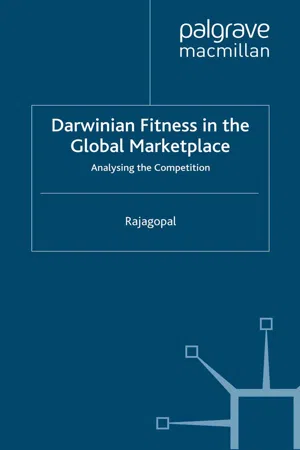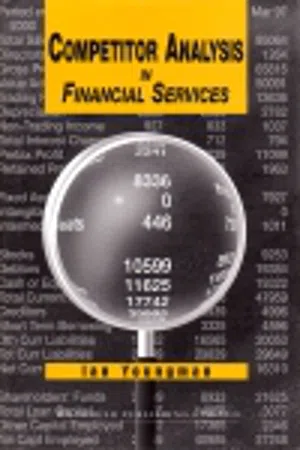Marketing
Competitor Analysis
Competitor analysis involves evaluating the strengths and weaknesses of rival companies within the same industry. This process helps businesses understand their competitive landscape, identify opportunities for differentiation, and make informed strategic decisions. By examining competitors' marketing strategies, product offerings, and market positioning, companies can gain valuable insights to improve their own competitive advantage.
Written by Perlego with AI-assistance
Related key terms
1 of 5
11 Key excerpts on "Competitor Analysis"
- eBook - ePub
Marketing Management
Text and Cases
- Robert E Stevens, David L Loudon, Bruce Wrenn(Authors)
- 2012(Publication Date)
- Routledge(Publisher)
niche performer with a unique strategy tailored for specific strengths and weaknesses and specific market segments. Each major competitor should be studied separately. If this is not possible then the strategy of the closest competitors should be evaluated.In evaluating different competitive approaches the following tasks need to be performed:- Review current strategy.
- Review current performance.
- Determine strengths and weaknesses.
- Forecast future strategic possibilities.
Analyzing current competitor strategy involves determining how the competitor defines the industry in terms of market segments, product features, marketing mix, manufacturing policy, research and development commitment, growth policy, distribution, and promotion. This analysis can take several forms, but perhaps the most useful is the competitive marketing mix audit.Who are Our Competitors?Major competitors are often easy to identify but some may be overlooked. One way of identifying competitors is to consider the product/market situation. All existing competitors should be identified based on the product/market they are satisfying. For example, a soft drink producer must specify all of the different choice options within the market under which his or her brand will be considered. This would comprise the bulk of the relevant set of competitors and indicates to the marketer that a variety of levels of competition may exist for a company. The most immediate level is brand and item competition. For example, the Palm IIIxe and the Handspring Visor Deluxe compete directly against each other in features and price points within the personal digital assistant (PDA) product category. At the next level—industry competition—a company competes with all other companies producing the same type of product. For example, Palm considers Brother, Casio, Compaq, Cybiko, Franklin, Handspring, IBM, Psion, Sharp, SONIC Blue, Sony, and Xircom as PDA industry competitors. At the generic - eBook - PDF
- C. West(Author)
- 2001(Publication Date)
- Palgrave Macmillan(Publisher)
In service businesses it is the basis of the service offer and the methods by which the service is to be delivered that need to be studied. 43 Framework for Competitive Analysis Sales and marketing intelligence The study of a competitor's sales record including an analysis of segments serviced, customers won and lost, market share and sales volumes provides a clear indication of performance. An analysis of marketing resources, processes, procedures and routes to market, coupled with a measurement of the volume (and cost) of marketing activity, provides a highly visible barometer of where a company is directing its effort and the intensity with which it is pursuing its sales objectives. Analysis of the language used in advertisements and promotional literature can also indicate how the competitor sees itself and tells something of the culture that is prevailing within the organisation. The study of marketing activities can be extended to cover the results of the process in terms of the customer base the company has succeeded in acquiring and its key accounts. The analysis can be taken further to consider the awareness of competitors, the relation- ship between competitors and their client bases, satisfaction with competitors' performance, the levels of client loyalty and the image of competitors in the marketplace. Pricing and discount intelligence Price is one of the key elements in the competitive battle and although competing on price is widely regarded as an admission of failure, it may nevertheless be the final arbiter of who wins the business. Prices are either extremely easy or extremely difficult to collect. Those that are displayed or published can be easily observed but where prices are tendered more sophisticated methods are required in order to obtain them. - eBook - ePub
- Richard M.S. Wilson, Colin Gilligan(Authors)
- 2010(Publication Date)
- Routledge(Publisher)
It follows from this that competitive analysis should be a central element of the marketing planning process, with detailed attention being paid to each competitor’s apparent objectives, resources, capabilities, perceptions and competitive stance, as well as to their marketing plans and the individual elements of the marketing mix. In this way, areas of competitive strength and weakness can more readily be identified, and the results fed into the process of developing an effective marketing strategy. Better and more precise attacks can then be aimed at competitors and more effective defences erected to fight off competitors’ moves. An additional benefit of Competitor Analysis, in certain circumstances at least, is that it can help in the process of understanding buying behaviour by identifying the particular groups or classes of customer to whom each competitor’s strategy is designed to appeal. This can then be used as the basis for determining the most effective probable positioning strategy for the organization.Recognition of these points leaves the strategist needing to answer five questions:- Against whom are we competing?
- What strengths and weaknesses do they possess?
- What are their objectives?
- What strategies are they pursuing and how successful are they?
- How are they likely to behave and, in particular, how are they likely to react to offensive moves?
Taken together, the answers to these five questions should provide the marketing strategist with a clear understanding of the competitive environment and, in particular, against whom the company is competing and how they compete. An example of this, which although it relates to Kodak in the 1970s, appears in Figure 7.2 and neatly illustrates the need to adopt a breadth of perspective in coming to terms with the complexity of the competitive environment.Figure 7.2 The competitive environment for selected Eastman Kodak products in the late 1970s (Adapted from Business Week, 20 June 1977)It is against the background of the picture that emerges from this sort of analysis that the marketing strategist can then begin to formulate strategy. In the example cited in Figure 7.2 - eBook - PDF
Market-Driven Management
Strategic and Operational Marketing
- Jean-Jacques Lambin, Isabelle Schuiling(Authors)
- 2012(Publication Date)
- Bloomsbury Academic(Publisher)
More columns can be added, represent-ing other marketing instruments. Delayed responses can also be analysed. For an example of an application in the electric razor market, see Lambin, Naert and Bultez (1975). Competitors’ analysis and monitoring system The attitude to be adopted towards competitors is central to any strategy. This attitude must be based on a refined analysis of competitors. Porter (1980, p. 47) describes the purpose of analysing competitors as follows: The objective of a Competitor Analysis is to develop a profile of the nature and success of the likely strategy changes each competitor might make, each competitor’s probable response to the range of feasible strategic moves other firms could initiate, and each competitor’s probable reaction to the array of industry changes and broader environmental shifts that might occur. There are several broad areas of interest that constitute the structure to guide the collection and analysis of information about competitors. The relevant questions are the following: What are the competitors’ major objectives? ■ What is the current strategy being employed to achieve the objectives? ■ What are the capabilities of rivals to implement their strategies? ■ What are their likely future strategies? ■ Together, these areas of information collection and analysis (see also Box 10.4) comprise a fairly complete picture of the competitors’ activities. Some companies have discovered the importance of Competitor Analysis. Some examples are: IBM has a commercial analysis department with thousands of branch office representa-■ tives responsible for reporting information about the competition. Texas Instruments has employees analyse government contracts won by competitors to ■ discern their technological strengths. Citicorp has an executive with the title “manager of competitive intelligence”. ■ McDonald’s distributes a Burger King and Wendy’s Competitive Action Package to its ■ store managers. - eBook - PDF
- David A. Aaker, Christine Moorman(Authors)
- 2023(Publication Date)
- Wiley(Publisher)
For example, considering supermarkets, customers could be asked questions such as the following: Which store is closest to your home? Which do you shop at most often? Are you satisfied? Which has the lowest prices? Best specials? Best customer service? Cleanest stores? Best-quality meat? Best-quality produce? and so on. Those chains that are well positioned on value, on service, or on product quality could be identi- fied and tracking would show whether they are gaining or losing position. The loyalty of their cus- tomer base (and thus their vulnerability) could be indicated in part by satisfaction scores and the willingness of customers to patronize their stores even when they are not the most convenient or the least expensive. Regular market research studies performed by syndicated services such as JD Power, Consumer Reports, Statista, or Mintel can be used in the same way as primary research. Just as companies can mine publicly available data for competitive intelligence, competitors can do the same. The company needs to assess the likelihood that competitors can make sense of this information and act on it. If so, the information should be protected vigorously. KEY LEARNINGS • Competitive analysis is a form of external analysis that provides several benefits including: a clearer understanding of which competitor threats merit a response; greater prediction of emerging competitor threats and opportunities; and better forecasting of likely competitor responses to company decisions. • There are two key approaches that can help companies identify current competitors: taking the perspective of the customer and leveraging a strategic group approach. • In addition to identifying current competitors, companies should assess the poten- tial for new market entrants by considering the probabilities and implications of Chapter 4 Competitor Analysis 85 market expansions, offering expansions, resource acquisitions, backward integra- tions, and forward integrations. - eBook - PDF
Darwinian Fitness in the Global Marketplace
Analysing the Competition
- P. Rajagopal(Author)
- 2012(Publication Date)
- Palgrave Macmillan(Publisher)
19 Competitor strategies The companies engaged in competitive business should aim at conducting the Competitor Analysis to build competitive advantage and this cannot be done in isolation from the market and the rest of the industry, because being better than a competitor will not guarantee success if what is offered gives little value to the customer. Hence, it should be understood by the firms that any inferences which might be drawn from Competitor Analysis must be considered in conjunction with the other environmental factors. Every company has strategic options, although this does not mean that all options are sensible for every company. It may choose to operate within the rules of the industry, without major change to what it offers. The options may include a stronger focus on a niche strategy, seeking to identify and exploit segments where its products would have an advantage, or what might be termed improvement strategies. A competing firm may be attacked in various ways by a new and prospecting business firm in a given territory in order to optimise the market advantage. The most effective way for a firm to attack may be through implementing a creative and entrepreneurial strategy on a sound knowledge analysis in view of the changes the competi- tive arena. Alternatively, a firm may attempt to pre-empt a competitor by getting into market first with a new product, in an area of strategic impor- tance. However attacking the strategy of a competitor can leave the firm in a weaker position. The prospecting firm may also attack on the competitor’s alliance instead of direct attack on the target. An example of this was the acquisition of Rover by BMW. There were undoubtedly many reasons for this acquisition, but one of them was to cause Honda to withdraw from the alliance it had operated for many years with Rover, and its predecessor British Leyland. Similar patterns of alliances changing allegiance have been observed in the airlines industry. - eBook - PDF
- Ian Youngman(Author)
- 1998(Publication Date)
- Woodhead Publishing(Publisher)
C H A P T E R The need for Competitor Analysis No firm can exist in a vacuum. It is vital to know who your competi-tors and potential competitors are and what they are doing. There is an enormous amount of information available, particularly since the launch of electronic services including the Internet. No company can afford to concentrate just on the country it is based in, nor just on the product areas it currently offers. Identifying, storing, disseminating and using competitor infor-mation is as much an art as a science. It needs resources and planning. Executive management may know, or think they know, bits and pieces about competitors, but tracking all those who are real competitors demands regular updating, analysing and filtering of the information available. Many managers may be against spending time and resources on monitoring competitor activity. They tend to think that the informa-tion they glean about competitors from reading the trade press and using staff sources gives them everything they need to know. Sales directors tend to be particularly over-confident, believing that their sales force knows all the gossip and news. This sort of information often amounts to little more than rumour, malicious gossip or delib-erately laid false trails, and is often out of date. What a company really needs to know is the information that has to be rooted out and analysed. C O M P E T I T O R A N A L Y S I S IN F I N A N C I A L SERVICES 1.1 The importance of Competitor Analysis Competitors are moving into financial services from all directions. It is not enough to develop competitive strategies and tactics based on sketchy information or broad based assumptions about what your competitors are doing. It is also no longer sensible to make plans in ignorance of what competitors are up to. It is increasingly essential to make decisions backed up by sound analysis and solid business intel-ligence. - eBook - PDF
- H. Aghazadeh(Author)
- 2016(Publication Date)
- Palgrave Macmillan(Publisher)
Furthermore this analysis provides information about the same issues about a company’s competitors with focus on their relative market positions, and strengths and weaknesses; and also helps a company to identify opportuni- ties and the strategies/tactics of exploiting these opportunities in an industry/ market. As a result of the analysis a company may be able to make effective deci- sions on preserving an advantage, creating an improvement, withdrawing from a market, etc. in both strategic and tactical levels. The steps of the process for applying the competitive positioning analysis are: 1. Identifying the focus of firm’s current strategy and analysis parameters 2. Conducting the analysis with undertaking market research, market seg- mentation, and industry analysis 3. Deriving insights from the analysis and formulating a positioning strategy for the firm The related tools and techniques are BCG growth/share portfolio matrix, product/market matrix, benchmarking, Competitor Analysis, customer seg- mentation analysis, financial ratio and statement analysis, GE business screen, industry analysis, product line analysis, supply chain analysis, SWOT analysis, value chain analysis. . Business Model Analysis (BMA) If a business model has been described as the rationale of create, deliver, and capture value by an organization in relation to its stakeholders (in particular Business, Market, and Competitive Analysis ● 201 customers), then it can be concluded that successful organizations are those who have a remarkable business model and magnificent execution of it. A business model consists of three main domains of internal (in which stake- holders’ perceived value is created), external (from which company’s expected value is captured), and their linkage/connection (through which the value is delivered to the stakeholders and is received by company). - eBook - PDF
- BB Brown, AJ Voges KD Knowles(Authors)
- 2015(Publication Date)
- Macmillan(Publisher)
M O D U L E 1 M O D U L E 4 Competitive analysis 72 Think about it 1. Why do you think it is important to know who your competitors are in an industry? 2. What kind of forces drive competition in an industry? 3. What factors make a business successful? Overview When you have completed this module, you should be able to: • Unit 4.1: Define the concept of an industry competitive analysis: name economic characteristics and understand how they influence a business; draw a profile for an industry-specific business; understand the concept of driving forces and identify driving forces at work in an industry; name and describe five competitive forces and understand their effects on a business; and identify the key success factors of a business. • Unit 4.2: Complete a task to identify and list the key success factors for an existing business. Unit 4.1: What is industry competitive analysis? Industry competitive analysis is also called Competitor Analysis. It is a process that has two elements, as shown in Figure 4.1. Collect information about your business’s industry and your main competitors in that industry Analyse and use the information you have collected to identify and understand: • Your competitors • Your competitors’ strategic focus • Potential competitor activities aimed at your business Industry competitive analysis or Competitor Analysis Figure 4.1: The elements of industry competitive analysis Figure 4.2: A business needs to know and understand the market position, market shares, strengths and weaknesses of its competitors 73 To understand your competitors, you need to identify their strategy, business objectives and capabilities. You do this by researching: • Information from competitors’ websites and annual reports. • General information about the industry in which you operate. For example, in Unit 2.6, you saw that you always need to be ahead of your competitors by learning faster than them. - eBook - PDF
Comprehensive Strategic Management
A Guide for Students, Insight for Managers
- Eric J. Bolland(Author)
- 2017(Publication Date)
- Emerald Publishing Limited(Publisher)
Major corporations like Procter & Gamble span many of the competitor categories. For them, a cor-porate level approach to strategy is necessary. The tool also has the limitation of not incorporating your own competitive position in the sequence of categories. Also, it does not depict the resources behind any competitor move. As a static model, it does not show direction of competi-tor moves. 218 COMPREHENSIVE STRATEGIC MANAGEMENT More than Competitors, It’s Competition Any consideration of individual competitors is incomplete as far as understanding the whole of competition. Competitors are atoms within a larger sea. It is essential to measure the sea itself, its currents, depths, tides, and temperature before saying sailing can be mastered. These can be very small and incremental hap-penings that nonetheless affect all competitors. They may not be discernable at all if it is one competitor watching another in a changing ocean. The competitive environment, where these forces dwell, shape what any competitor can do, not just what they actually do. Concentrating only on individual organizations may exagger-ate their characteristics at the expense of seeing the big picture. Individual competitors rise and fall continuously and this is a kind of white noise for an industry. The industry heaves too and carries with it all the organizations so that ship to ship move-ments become less obvious. There are tools that strategy managers can use to assess the competitive environment as a whole. One is the PEST analysis. The PEST analysis can be enhanced for the competitive environ-ment analysis by inspecting each of the four elements and decid-ing both the strength of that element in comparison to the others and by determining the immediacy of the factor. This means trends and timing issues of the element are given priority. A very strong factor such as interest rate changes has a major impact on the fi nancial services along with when that interest rate might change. - eBook - PDF
Advertising & Promotions NQF3 SB
TVET FIRST
- Sparrow Consulting(Author)
- 2013(Publication Date)
- Macmillan(Publisher)
Step 5 The final step is to give your customers what you said you would. This is a way of building trust among customers. Competitor product display Before launching a new product on the market, think about what your competitor’s products look like and what functions they fulfil. This analysis will give you an idea of what type of products the market needs and what your customers want. Figure 11.3: Remember to think about what your competitors’ products look like. Retain : Keep; continue to have. Cater : Provide. Words & Terms It is really tough to analyse competitors because they will not simply give you the information you want. After all, you will not provide them with your information. Therefore, you will need to get the information via another route. Think about it 155 Module 11: Retaining the competitive environment of products or services Sales analysis A sales analysis is a way to measure how well certain products do in the market. You will be able to compare your sales as well as the competition’s sales within a certain time. After collecting this valuable information about the products, you will know your standing as well as that of your competitors in the market. Assessment activity 11.1 Individual activity Choose any product and analyse this product’s direct, indirect and future competitors. Explain what products or services could be substituted for the product, and why customers would choose these substitute products above your product. Your assignment must be at least one A4 page in length. You may include an illustration or the package of your product. Unit 11 . 2: Regular review of marketing industry advances and technology to maintain a competitive edge A competitive edge is “something” a company does a bit better than its competitors. This can be things like: • Great quality products. • Fast delivery. • Accurate processing, etc. There are many different things that an organisation can do or use to get (and maintain) a competitive advantage.
Index pages curate the most relevant extracts from our library of academic textbooks. They’ve been created using an in-house natural language model (NLM), each adding context and meaning to key research topics.










